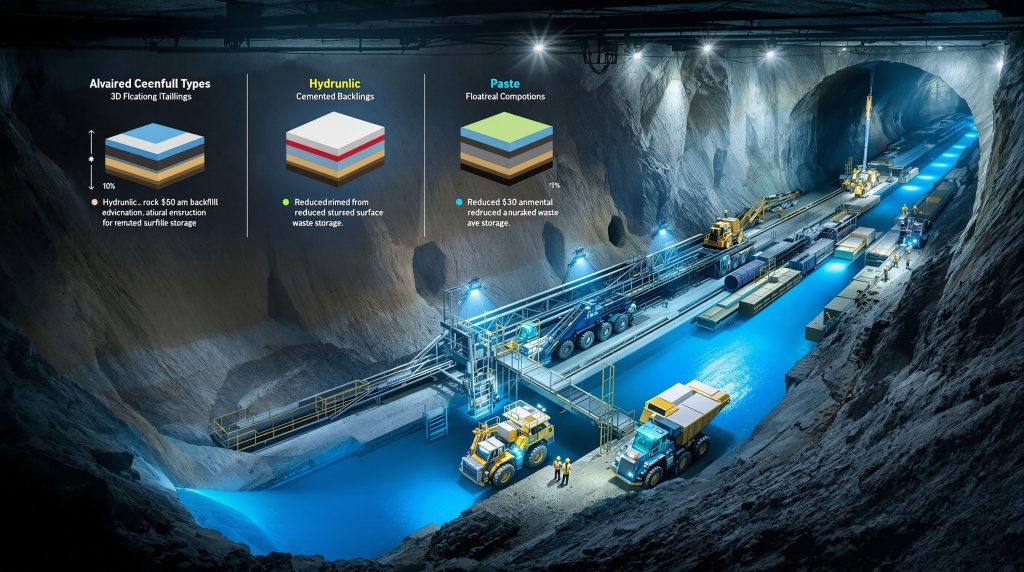Innovative Mine Waste Backfilling Strategies: Sustainable Solutions for Underground Mining
Mine waste backfill represents a sustainable approach to underground mining operations where waste materials are repurposed to fill excavated areas. This innovative practice transforms potential environmental liabilities into valuable resources that support ongoing mining operations while significantly reducing surface footprints and environmental impact.
The Environmental and Operational Significance of Backfilling
Effective mine waste backfilling delivers multiple benefits that extend beyond simple waste disposal:
- Reduces surface storage requirements for tailings and waste rock by 40-60%
- Minimizes land disturbance associated with mining activities
- Decreases potential for environmental contamination from exposed waste materials
- Provides crucial structural support for continued mining operations
- Enables safer mineral extraction in areas with weak host rock formations
Key Materials Used in Mine Backfill Operations
Several materials contribute to successful backfilling operations:
- Tailings from mineral processing operations (the fine-grained waste product)
- Waste rock from development and production activities
- Water for hydraulic and paste applications
- Binding agents (typically cement) for strength development
- Industrial by-products as supplementary materials to reduce costs
What Are the Primary Types of Mine Waste Backfill Systems?
Different mining operations require specific backfill approaches based on unique geotechnical requirements, available materials, and operational constraints. The three most widely applied backfill systems each serve specific purposes within the mining environment.
Hydraulic Fill: Fluid-Based Support Systems
Hydraulic fills offer a cost-effective solution for many mining operations:
- Utilizes de-slimed tailings with carefully controlled particle size distribution
- Requires drainage systems to remove excess water after placement
- Incorporates binders (typically 2-5% cement) for mechanical strength development
- Achieves moderate strength after appropriate curing periods (typically 28 days)
- Offers an economical solution for many mining applications where moderate strength is sufficient
Rock Fill: Solid Waste Utilization
Rock fill systems repurpose waste rock effectively:
- Primarily consists of waste rock from mining development operations
- Provides immediate structural support without extensive curing periods
- Can be used in dry backfilling applications where drainage is limited
- Particularly suitable for sublevel stoping in hard rock environments
- Often utilized where high strength is required quickly with minimal preparation
Cemented Paste Backfill (CPB): Advanced Engineered Solutions
CPB represents the most technically advanced backfill solution:
- Combines tailings with precise amounts of water and binders
- Creates a non-settling, homogeneous material with controlled consistency
- Achieves compressive strengths of 1.5-3 MPa after 28 days of curing
- Requires site-specific optimization for each mining operation and tailings type
- Offers superior performance characteristics for demanding applications
How Does Backfill Support Mining Methods and Ground Control?
The selection of appropriate backfill systems directly correlates with specific mining methods and ground control requirements. Different extraction techniques demand tailored backfill approaches to maximize both safety and resource recovery.
Cut-and-Fill Mining Applications
In cut-and-fill mining, backfill plays an essential role:
- Provides critical support in weak host rock environments where ground stability is a concern
- Creates a working platform for subsequent mining cycles, enabling vertical progression
- Enables controlled extraction in challenging ground conditions that would otherwise be unsafe
- Requires engineered strength to withstand mining-induced stresses during adjacent extraction
- Facilitates higher recovery rates of valuable ore that might otherwise be left as support pillars
Sublevel Stoping Considerations
For sublevel stoping operations, backfill requirements differ:
- Less critical in hard rock environments with natural self-supporting capabilities
- May utilize simpler backfill solutions like dry tailings or crushed waste rock
- Primarily serves to prevent subsidence rather than provide active support
- Allows for efficient disposal of mine waste while maintaining void stability
- Reduces surface disposal requirements while maximizing extraction ratios
Preventing Subsidence and Secondary Hazards
Strategic backfilling provides crucial protection against various hazards:
- Prevents surface subsidence in undermined areas, protecting surface infrastructure
- Particularly important in earthquake-prone regions where ground movement is a concern
- Helps prevent secondary disasters like down-hole debris flow in seismically active zones
- Reduces potential for groundwater contamination by isolating potentially reactive materials
- Requires carefully engineered solutions tailored to site-specific geological conditions
What Are the Technical Parameters for Effective Backfill Performance?
Successful implementation of mine waste backfill requires careful attention to material properties and performance metrics. These technical parameters determine whether a backfill system will perform as required under operational conditions.
Critical Strength Requirements
Strength development in backfill materials is essential for operational safety:
- Compressive strength typically ranges from 1.5-3 MPa after 28 days of curing
- Strength development directly correlates with binder content (typically 2-5% by weight)
- Higher strengths required for primary stopes versus secondary stopes due to exposure conditions
- Strength requirements increase with depth due to greater stress conditions in deeper operations
- Backfill must withstand both static and dynamic loading conditions, especially in seismically active areas
Permeability Considerations
The permeability of backfill materials affects both stability and environmental protection:
- Moderate permeability (10⁻⁴ to 10⁻³ cm/s) provides optimal performance in most applications
- Allows controlled drainage while maintaining structural integrity of the placed material
- Prevents buildup of hydraulic pressure within backfilled areas that could lead to failure
- Facilitates consolidation and strength development through appropriate water management
- Plays a crucial role in groundwater protection and management within mining operations
Material Composition Optimization
The precise composition of backfill mixtures significantly impacts performance:
- Mass concentration typically ranges from 81-83% solids for optimal placement characteristics
- Waste rock content varies from 25-30% of total mix to balance strength and resource utilization
- Cement or binder addition ranges from 2-5% by weight depending on strength requirements
- Water quality (pH, dissolved solids, sulfate content) significantly affects setting time and strength
- Anti-disintegration properties are critical for long-term stability, particularly in wet conditions
How Are Backfill Strategies Implemented in Practice?
Successful backfill operations require comprehensive planning and strategic implementation approaches tailored to site-specific conditions and operational requirements.
Strategic Backfilling Approaches
Several strategic approaches have proven effective in mining operations:
- Vertical stratification techniques create layered backfill zones with different properties for optimal stability
- Horizontal partitioning controls subsidence effectively by creating stable zones within the backfilled area
- Combining cemented and non-cemented zones balances cost efficiency with performance requirements
- Sequential filling supports adjacent mining activities while maintaining overall ground stability
- Phased implementation based on mining sequence ensures ground control needs are met throughout operations
Case Study: Subsidence Control in Earthquake-Prone Areas
The Tong Cheng mine in China demonstrates effective backfill implementation:
- Combined cemented and non-cemented backfill proved most effective after comparative testing
- A strategic backfilling approach using vertical stratification and horizontal partitioning was developed
- The backfill paste achieved satisfactory anti-disintegration properties for long-term stability
- Moderate permeability (10⁻⁴ to 10⁻³ cm/s) facilitated appropriate drainage characteristics
- The implementation successfully prevented secondary hazards in a seismically active region
Economic Considerations in Backfill Operations
Financial aspects must be carefully evaluated:
- Backfilling represents an additional operational cost that must be justified through multiple benefits
- Cost-benefit analysis must balance expenses against environmental benefits and safety improvements
- Enabling extraction of ore that would otherwise be inaccessible often provides significant economic return
- Reduced surface tailings management costs and long-term liabilities offset immediate expenses
- Optimized resource recovery from mining operations improves overall project economics
What Are the Environmental Benefits of Mine Waste Backfill?
The environmental advantages of backfilling extend far beyond simple waste disposal to comprehensive sustainability improvements that benefit both mining operations and surrounding communities.
Reducing Surface Footprint
Backfilling significantly reduces the surface impact of mining activities:
- Decreases land area required for tailings and waste rock storage by up to 60%
- Minimizes visual impact of mining operations on surrounding landscapes
- Reduces dust generation from surface tailings facilities, improving air quality
- Decreases potential for surface water contamination from runoff and erosion
- Facilitates more effective site rehabilitation during and after mining operations
Preventing Groundwater Contamination
Underground storage through backfill provides superior environmental protection:
- Encapsulates potentially reactive materials underground, away from oxygen exposure
- Reduces exposure of sulfide minerals to oxidation that can generate acid mine drainage
- Controls acid generation potential through isolation from water and oxygen
- Minimizes leaching of metals into groundwater systems through controlled permeability
- Creates more stable long-term storage conditions than surface impoundments
Supporting Mine Closure Planning
Backfill operations contribute significantly to successful mine closure:
- Provides permanent, stable storage solution for mine waste that reduces closure liabilities
- Reduces long-term monitoring and maintenance requirements after mining concludes
- Facilitates more complete site rehabilitation by minimizing surface disturbance
- Decreases post-closure environmental liabilities and associated financial assurance
- Supports sustainable mining practices throughout the entire mine life cycle
What Innovations Are Advancing Mine Waste Backfill Technology?
The field of mine waste backfill continues to evolve with technological advancements and innovative approaches that improve performance while reducing costs and environmental impacts.
Alternative Binder Systems
Innovative binding agents are transforming backfill economics and sustainability:
- Partial replacement of traditional Portland cement with industrial by-products reduces costs
- Utilization of slag, fly ash, and other pozzolanic materials decreases carbon footprint
- Development of geopolymer binders offers enhanced performance with lower environmental impact
- Optimization of binder formulations for specific tailings characteristics improves efficiency
- Custom binding systems address challenging conditions while maintaining cost effectiveness
Advanced Monitoring and Quality Control
Technology is revolutionizing backfill management:
- Real-time monitoring systems track backfill placement and performance throughout operations
- Instrumentation technologies measure strength development and settlement in situ
- Comprehensive quality control protocols ensure consistent material properties
- Predictive modeling capabilities forecast long-term backfill behavior under various conditions
- Integration with mine-wide monitoring systems provides holistic ground control management
Tailings Pretreatment Technologies
Emerging processing approaches enhance backfill performance:
- Enhanced dewatering techniques improve material handling and reduce transportation costs
- Selective particle size management optimizes performance characteristics
- Advanced methods remove deleterious minerals that could inhibit strength development
- Chemical treatment technologies neutralize potentially harmful components before placement
- Process optimization reduces energy consumption while enhancing backfill quality
How Can Mine Operators Optimize Backfill Systems?
Successful implementation requires careful consideration of site-specific factors and operational requirements to maximize benefits while controlling costs.
Site-Specific Optimization Strategies
Every mine requires a customized approach:
- Tailoring backfill recipes to specific ore body characteristics and waste material properties
- Accounting for local water chemistry and material characteristics during formulation
- Adjusting placement strategies based on ground conditions and mining sequence
- Balancing strength requirements against economic constraints for each application
- Integrating backfill operations with overall mining sequence for maximum efficiency
Operational Efficiency Improvements
Streamlined processes enhance backfill performance:
- Optimizing material handling and transport systems to reduce operational costs
- Implementing efficient mixing and delivery infrastructure suited to site conditions
- Deploying automated control systems for consistency and quality assurance
- Minimizing energy consumption through improved process design and equipment selection
- Reducing operational downtime through preventative maintenance and system redundancy
Performance Monitoring and Continuous Improvement
Ongoing assessment drives optimization:
- Regular testing of backfill material properties throughout the production process
- Tracking strength development against design requirements to validate performance
- Analyzing cost-effectiveness of different backfill strategies to identify opportunities
- Documenting lessons learned from each application to build institutional knowledge
- Implementing continuous improvement initiatives based on operational experience
What Are the Future Trends in Mine Waste Backfill?
The evolution of backfill technology continues to address emerging challenges and opportunities in the mining industry, with several key trends shaping future developments.
Integration with Broader Sustainability Goals
Environmental considerations are increasingly driving innovation:
- Carbon footprint reduction through alternative binder systems and efficient processing
- Water conservation through improved dewatering technologies and water recycling
- Energy efficiency improvements in material preparation and transport systems
- Life cycle assessment approaches to evaluate total environmental impact
- Alignment with decarbonisation benefits for responsible mining operations
Digital Transformation in Backfill Operations
Technology is revolutionizing backfill management:
- Implementation of IoT sensors for real-time monitoring of placement and performance
- Digital twin modeling provides comprehensive visualization of backfill operations
- Predictive analytics enable proactive quality control and operational optimization
- Automated placement systems improve efficiency and safety in challenging environments
- Integration with mine planning software creates holistic optimization opportunities
Regulatory and Standards Development
Evolving frameworks guide implementation:
- Development of comprehensive guidelines for backfill design and implementation
- Standardization of testing protocols and performance metrics across the industry
- Establishment of industry best practices for different applications and environments
- Integration of backfill considerations with mine closure planning requirements
- Alignment of operational practices with evolving mine reclamation innovation approaches
FAQ: Common Questions About Mine Waste Backfill
What percentage of mine tailings can typically be used as backfill?
Approximately 40-60% of tailings produced in mining operations can be repurposed as backfill material, significantly reducing the volume requiring surface storage while providing valuable underground support. This recycling rate varies based on ore type, processing methods, and specific mine requirements.
How does backfill contribute to mine safety?
Backfill enhances mine safety by stabilizing excavated areas, preventing uncontrolled ground movement, supporting adjacent mining activities, and reducing the risk of sudden collapse or subsidence events. It creates more stable working environments throughout the mining sequence.
What determines the strength requirements for backfill?
Strength requirements are determined by multiple factors including mining method, depth of operation, stope dimensions, sequence of extraction, ground stress conditions, and whether the backfill will be exposed during subsequent mining. Primary stopes typically require higher strength than secondary stopes.
Is backfilling economically viable for all mining operations?
While backfilling represents an additional operational cost, its economic viability must be assessed holistically, considering benefits such as increased ore recovery, reduced surface storage requirements, enhanced safety, and decreased environmental liabilities. The cost-benefit analysis varies significantly between operations.
How long does backfill typically take to achieve design strength?
Most cemented backfill systems achieve their design strength within 28 days of placement, though this varies based on binder content, material properties, and environmental conditions. Testing typically shows compressive strengths between 1.5-3 MPa after this curing period, with some applications requiring earlier strength development for operational continuity.
The Strategic Value of Mine Waste Backfill
The utilization of mine waste as backfill represents a cornerstone of sustainable mining practice, transforming potential environmental liabilities into valuable operational assets. By repurposing tailings and waste rock within underground voids, mining operations can simultaneously address mining waste solutions challenges, enhance ground stability, improve resource recovery, and reduce environmental impact.
The proper implementation of backfill systems provides immediate operational benefits while contributing to long-term environmental protection. With mass concentrations typically ranging from 81-83% solids, waste rock content between 25-30%, and cement additions of 2-5%, engineered backfill materials achieve the necessary strength and stability characteristics to support ongoing mining activities.
As mining continues to advance toward more sustainable practices, backfill technology will play an increasingly important role in balancing economic, environmental, and safety considerations. Through ongoing industry innovation trends, monitoring technologies, and placement methods, mine waste backfill systems continue to evolve, offering even greater benefits to mining operations and surrounding communities.
The strategic implementation of appropriate backfill systems, tailored to site-specific conditions and operational requirements, enables mining companies to extract resources more completely, operate more safely, and leave a smaller environmental footprint. This represents a genuine win-win scenario for industry and environment alike, turning what was once considered waste into a valuable resource that supports both operational and sustainability goals through renewable mining solutions.
Readers interested in learning more about mine waste management and backfilling techniques can explore related educational content in academic publications such as the Journal of Cleaner Production and resources from mining engineering institutions that offer additional perspectives on sustainable mining practices.
Ready to Discover the Next Significant Mineral Find?
Don't miss potential market-moving discoveries on the ASX—Discovery Alert's proprietary Discovery IQ model transforms complex mineral data into actionable insights, delivered in real-time to your inbox. Explore why historic discoveries generate substantial returns by visiting the dedicated discoveries page and position yourself ahead of the market.




